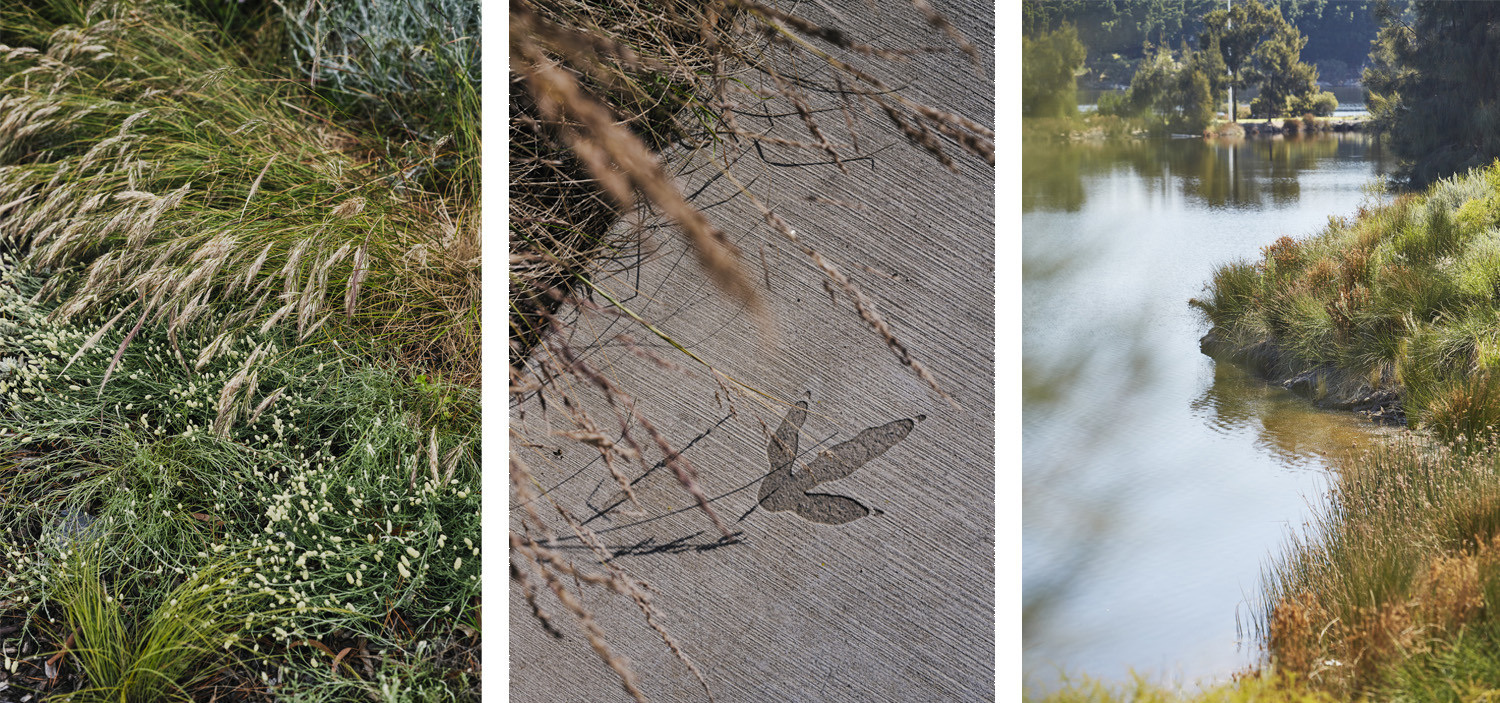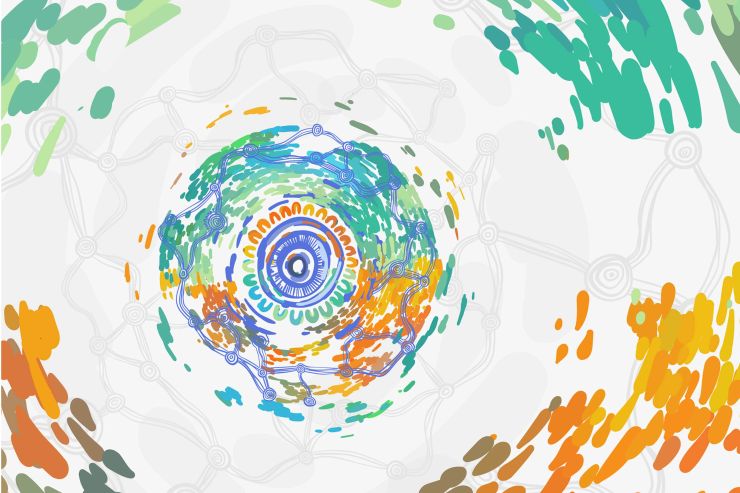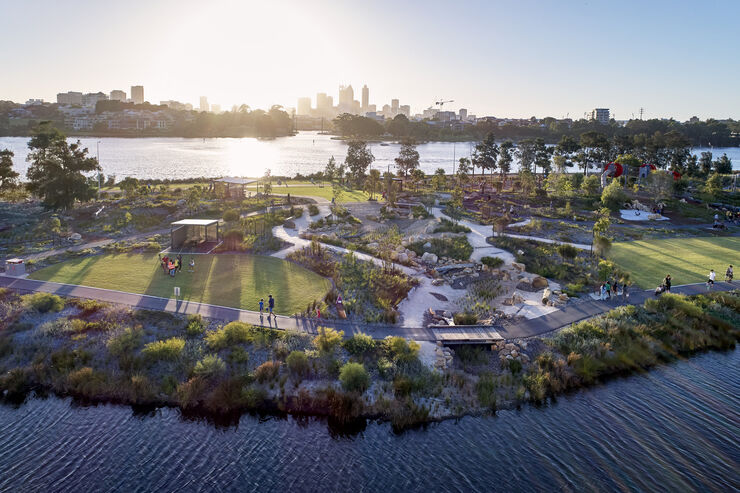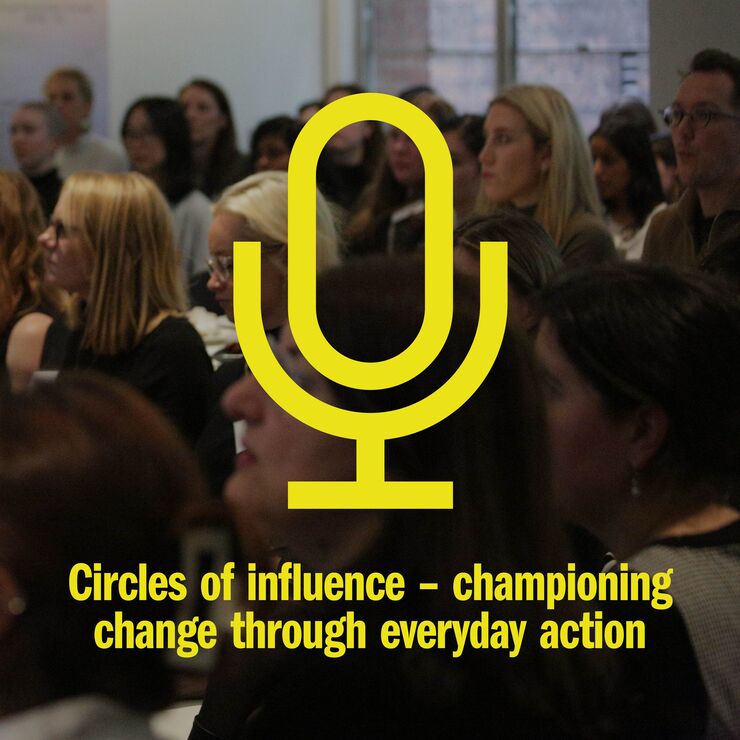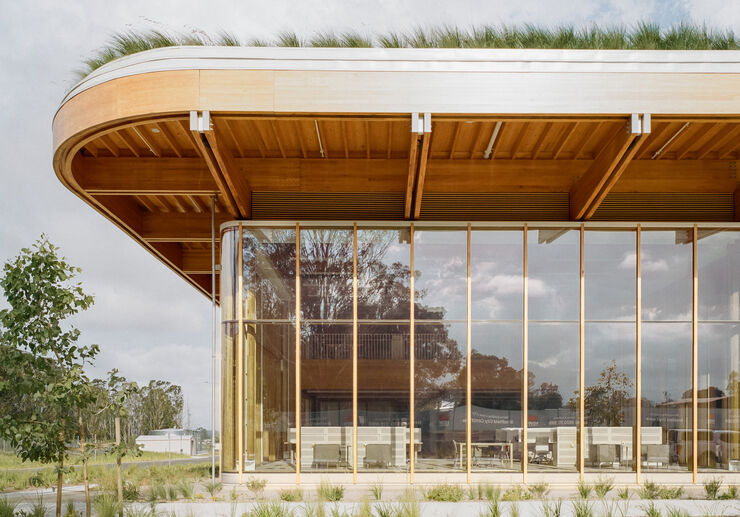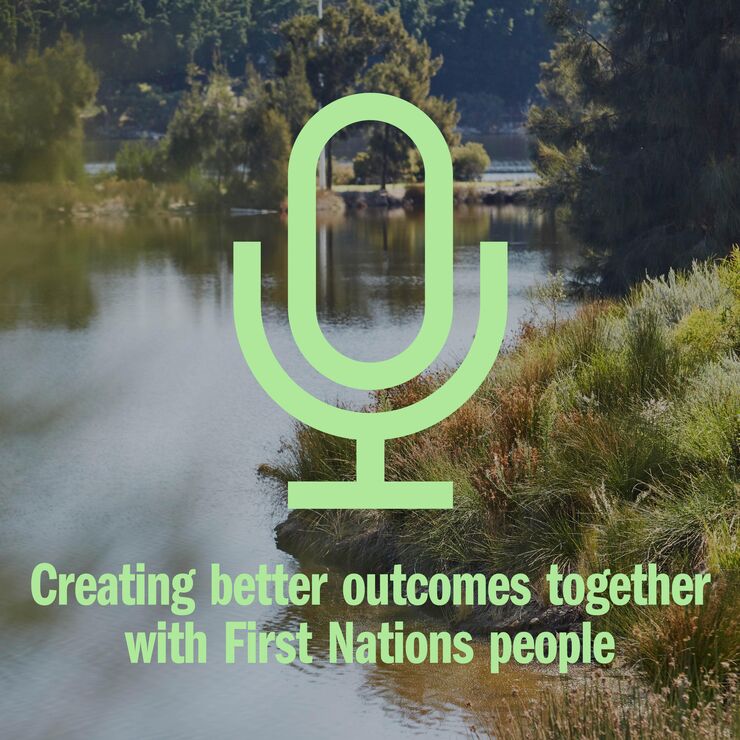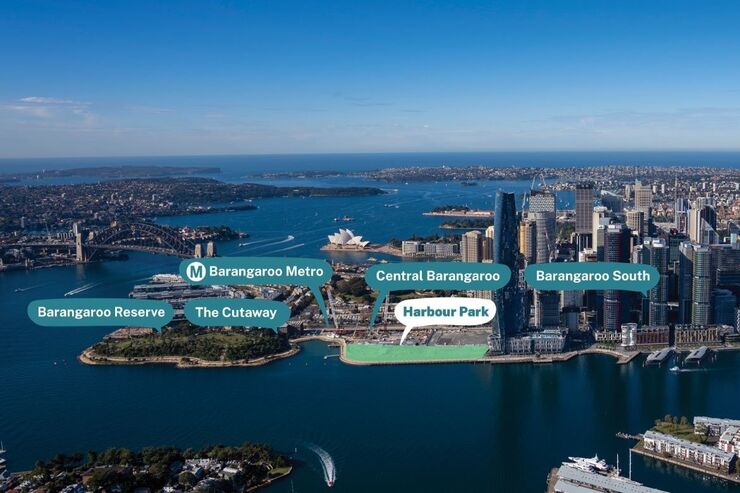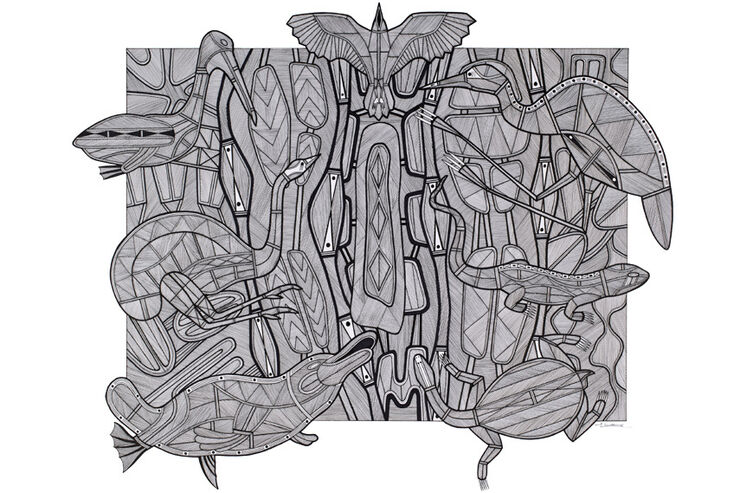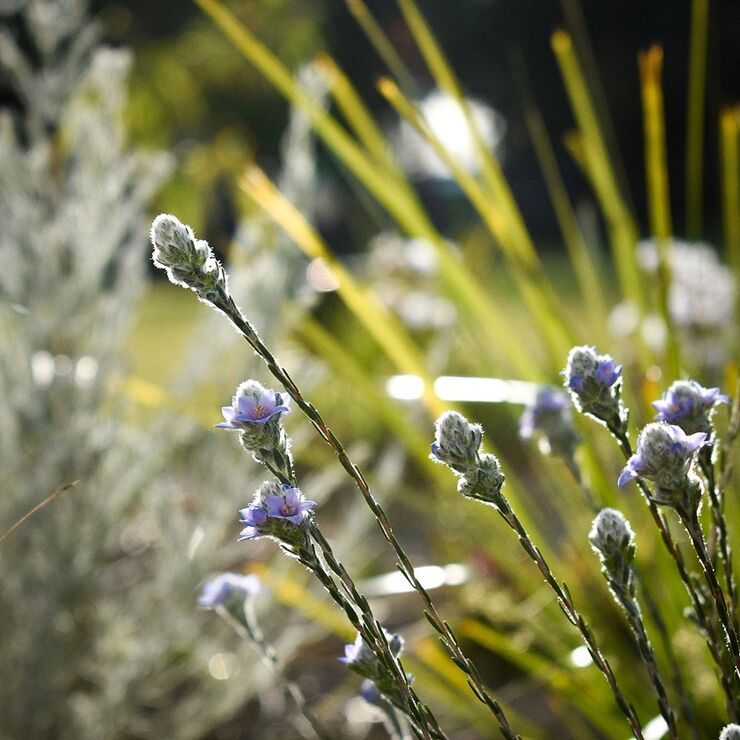Transcript - Part 1
Bird and insect sounds, followed by theme music.
Hannah Galloway introduces episode:
From global design practise, Hassell, this is Hassell Talks. Welcome back. I’m Hannah Galloway. I’m a landscape architect in Hassell, Perth Studio. And I’m your host this episode. I’m joined by Kat Rodwell.
Kat’s a First Nations Consultant, Cultural Advisor and Storyteller. And Kat is someone we at Hassell and many organisations turn to on projects, to educate and guide us on our journey to knowledge.
Where I am, I’d say kaya, which is hello. I’d say Kat welcome, which is Wanju and that’s in Noongar language.
Kat Rodwell:
Yuma, which is hello on Ngunnawal country. But I’m in on Wadawarrung country.
Hannah Galloway:
Thank you. So before we go any further and before we make any further introductions, which I can’t wait to do, I’d just like to acknowledge and respect the Noongar Whadjuk people and the Wadawurrung people as the original custodians of the land on where we are recording today. And acknowledge their unique ability to care for country and heir deep spiritual connection to it.
We honour elders, past, present and emerging, whose knowledge and wisdom has and will ensure the continuation of cultures and traditional practises.
Hi Kat, how are you and who are you and can you tell us a little bit about you, yourself?
Kat Rodwell:
I love, who are you? I don’t know half the time who I am. I’m still learning who I am. I’m guided by ancestors of past and all the elders from past and elders today. I’m so lucky that I’m guided by them in everything I do, which is amazing.
Where do I start? Well, proud Ngunnawal Woman. Grew up on Dharawal country and La Perouse, as everybody would say, swimming with anything and everything in the ocean. I’m a water baby. Absolute water baby. And a shark fanatic I should say.
Hannah Galloway:
And thank you so much for joining us today and it is lovely to see you again.
Kat Rodwell:
Well we’re going to have an epic yarn, I call this. And I always start off these by saying let’s get comfortable with being uncomfortable. And that means me as well. And we walk this together. So the questions that we talk about, it means that let’s be truthful, that raw truth telling. And this is what we’re going to do today.
Hannah Galloway:
Kat and myself have worked together before. We met back in 2021, deep in the midst of Covid. So we’ve only ever spoken online. I’ve never actually met you in-person because I’m over in Perth and you are over in Victoria. So if you could just explain to us a little bit, Kat, about what it is that you do?
Kat Rodwell:
A lot. In a nutshell, I suppose what I do is I act as a go- between or the old-fashioned sifting. You put your flour in and sift through everything, all the information, so it comes out properly.
I help to work with traditional owners, elders and community, work with projects and work with architects and design teams and other facets of that project, to make sure that their voice is heard. That they have a seat at the table. And not just the seat every now and then, that they’re like project managers, that they have the ability to say, hey, we’re not happy with that. Can you change this? What about this?
So they’re included in their own home, which is effectively what the projects are, on someone else’s country doing their home. I also help the project teams and architects to be able to understand country, the culture, the protocols, to understand the history, cultural mitigation, but also take the team on a cultural journey.
And when I say, that’s not death by PowerPoint, it’s taking them on a journey, where you can ask any question you want for fear of saying, oh, have I asked the wrong question? Oh my gosh, is she going to be angry with me? I’m here to help, I’m here to bridge that, to make sure that we all work together, we all walk alongside together, so that the outcome is this beautiful storytelling through the building, through the structure. And that country has a voice loud and clear. And that everyone hears it, sees it, smells it, and can feel it.
The other things I do is have a look at, as I said, my Bush Tucker, Bush medicine classes. So you get to immerse in culture. And the other part I do is I fix the mistakes, like a sweeper. I’m good at sweeping, so people say. So helping people to understand that it’s okay to make mistakes, but work with us.
Hannah Galloway:
Yes. To just introduce myself as well. So I am a landscape architect with Hassell. I’ve been working with Hassell now for nearly 20 years. Gosh, is it that long?
I have had the privilege of during that time working on so many different projects in so many different sectors. And since moving to the Perth office over the last 13 years, all of those have had wonderful engagement processes with First Nations people. So they’ve ranged from St. John of God’s public and private hospital. Perth, Optus Stadium, Boola Bardip WA Museum, Roebourne District High School, which was a wonderful process. And that’s ongoing at the moment.
And I’ve also lectured and tutored modules with Curtin University in some of the work that they’ve been doing with the Healing Centre for the Stolen Generation Mission, out at Wandering. So I personally have a deep respect for First Nations people and a huge interest in culture and the spiritual connection to the places that surround us. And that is where I come from in regards to those really interesting discussions.
Which leads me, I suppose into what the intent of today’s chat is all about, is I think for wider context to people all around the world who may be listening, I wanted to first touch on why it’s so important to have these conversations and these discussions with First Nations people in Australia. As traditional owners, the cultural connection that you’ve had over 1000s of years with place and the understanding of systems and that spiritual connection to Australia itself.
I just feel as though it’s so imperative and so important that any change to place or any further understanding of place is done in a discussion with First Nations People. And that helps us as landscape architects and architects and designers of spaces for people, to better understand the places and the systems and the spirituality and the connections, to be able to move forwards together in partnership and create better spaces for everyone. What’s your understanding of engagement Kat?
Kat Rodwell:
For me, we talk about the term listening, and this is about engaging. We need to listen and for us, our mob, our people all around Australia and probably like every other culture, is we listen not only with your ears but with our eyes, with what we see, with what we hear, with what we smell, with what we touch. That’s how we hear.
So it means that we are grounded with country because mother is our country. She looks after us and we look after mother in turn. She nourishes us, we nourish mother. So we’ve got to listen to her with all those senses. So for me, engaging is using all those senses when we speak, when we talk to our traditional learners, when we listen to them, when we listen to our elders, because they are the caretakers of country, they’re the ones that tell us the stories of the past and bring them to the present.
They’re the ones that share all the knowledge of the 100s and 1000s of years. They’re the ones that show us how to live with mother, with country. How to learn from country, how to respect country, so that we can coexist together. That’s engaging. That’s the short version.
Hannah Galloway:
That’s so beautiful and so beautifully put. And so it is a full sensory immersion in a way. And somebody once described it, a traditional, he described it to me as an exchange of energy as well. That connection is something that can be literally felt through an exchange of energy. The more people that are in a place, the more the energy can build up as well. And the exchange of energy between the ground and the country itself resonates and builds up. Is that correct?
Kat Rodwell:
Exactly. So I’m thinking of… What’s the movie with the blue people? Avatar. When I was watching Avatar and how they were talking about they were all one. With everything they saw, they were all connected with that same energy.
That is the same with us. And when I saw them, how they were saying that there’s this energy that the ground, the trees, the animals, they all work in sync together. That’s how we feel about country and the energy. And when I saw that movie I went, oh wow, bang on, bang on. That’s what it’s like, our connection to country, all those senses.
And you’re right, it’s like being… Sometimes the more people we have at our celebrations and properties, your rock concerts. You’re rocking on and all this energy builds and builds and builds because you’re all sharing that time, that space, that moment with everyone, and grounded on country. Once again, what you see here, smell, touch.
Hannah Galloway:
And I suppose that if we’re understanding, and I suppose taking the example again from Avatar, it’s just expressing in that way all of how natural systems are all in interconnected and interwoven. And if we change one element, so that as architects and developers and the sectors that we’re in, you’re changing one aspect of it and it has such a detailed and knock-on effect, to the balance of all of those systems. So again, it’s having these conversations to go on that journey together, to understand impacts to all I suppose.
Kat Rodwell:
Yeah, one cannot exist without the other. That’s why we say water for all of us is the giver of life. And it is for anyone, without water we cannot survive. So that’s just an example of it. So yeah, anything, we all exist.
A famous uncle, who’s passed away, was saying… He’s now in the dreaming and he always said, we don’t own the land, the land owns us. Nothing is older than the land. And that was how it was said. It was beautifully said. That’s our connection.
Hannah Galloway:
It is beautifully said. The different cultural backgrounds are what makes these discussions so fascinating because it’s just a continuous absorption of learning. But I think that what some people might find difficult is to connect to something that’s very natural in the systems when they’re stood in the middle of central business district.
Do you know what I mean? So that you’re surrounded with buildings, the systems are not visible to you, the connection is not obvious and literal. So I imagine there’s still a connection there for yourself. And can you explain how you listen to country still in say for example, the city centre?
Kat Rodwell:
Yeah, we call it living culture. So it’s living cultural heritage, because it is seen everywhere. It is heard everywhere. We can touch it everywhere. Unlike, let’s just say where you are from, in your country. Give me something that’s… What’s one of your main big cultural features in your country? What are something everybody knows?
Hannah Galloway:
You can go landscape features, but originally from the UK you probably end up with somebody saying The House of parliament, Big Ben, do you know what I mean? There’d probably be landmarks or Stonehenge or something like that.
Kat Rodwell:
Thank you. Stonehenge. So places like that, our culture, we just touch the ground and we’ll have artefacts come up, our middens, et cetera. The landscape itself is our culture.
So having said that, what we say, our culture still oozes through the cement and the concrete and everything. It is still there because our connection is so strong, the spiritual connection.
So another question, this is building it up to it. When you fly, you’ve been into Melbourne I gather.
Hannah Galloway:
Yeah.
Kat Rodwell:
Okay. When you’re coming in on the aeroplane, I think I’ve asked you this question before, you’re just about to fly into the airport, when you’re looking down over Melbourne, what do you really see?
Hannah Galloway:
But when you’re that far up and that high up, you see landscape, you see systems. I see the tops of the hills, the valleys and the difference between where country starts and city starts and the details are gone. For example, a landmark that I was describing is not visible from an aeroplane but a larger geographical region or whatever is.
Kat Rodwell:
Yeah. Because a lot of people will say I see buildings and not much greenery and we always use this. And for me I see it differently, it’s like an in-built system within us, our connection to country, that’s spiritual. I see, immediately I’ll go to the waterways, I’ll immediately find a bit of green so to speak. I see beyond, below the concrete jungle so to speak, because country is still speaking through it, speaking to us. Sky country, star country, the trees, the wind.
So when I go into places, in Melbourne for example, when you walk through it and we call it the Pentridge Jail look, which is the blue stone walkways, which is just… Oh, it makes you feel enclosed, but always find that connection coming through it. So usually I get people to stand there and to close your eyes and the first thing is okay, everyone’s seems to be able to use ear, listening first, it’s the first thing of connection.
And we take that time to just stop, because Melbournites really don’t stop, they just keep going. So we say stop, breathe, connect. So stop, breathe, connect to country the first step. And we say listen, what do you hear? And when they’re really listening, it’s amazing.
(Breeze sounds play)
Kat continues: Most will say I can hear the wind, I can hear some of the wind, you can hear it sometimes in the trees, and the leaves. And I go, that’s our ancestors talking to you, the wind and the leaves.
Every now and then someone will go, oh I can actually hear people walking. I go, that’s good. Our ancestors are walking with you. And some will say, depending on where we are, I can hear a bird or two, which is quite rare in the city. And they go, how good is that? Our ancestors are talking through the birds to you.
(bird sounds play in background)
Kat continues: And I go, okay, what else can you see beyond the buildings? And some people say the trees and the movement of the trees, swaying. I can see the sky, sky country. Doesn’t matter whether it’s blue or black, you can see it. I can see the clouds. At night I can see the stars, star country. Or they’ll see some birds fly over. Or sometimes they will see people laughing, people talking. That’s the connections all coming through.
They’ll see the Birrarung, the Yarra River. And I say okay, what do you smell? And someone goes, all I can smell are the cars and that. And I go, okay, connect. What can you smell? And it’s quite amusing because then people block out the car smells and they start to think of some of the food smells and go, okay, what else? And every now and then someone will go, I can actually smell some of the leaves coming through. It may not be the eucalyptus leaves because there’s not many left in the city, but it’s the smell of country. And it’s okay if they say I smell different foods and that. That’s the smell of country as well.
Then we go walk around a bit and let’s have a look. And when you find some of the trees and that, I get them to touch. Because that’s our ancestors as well. And the trees are grounding, they’re strong and their root system is strong and connects us to country. And with all the leaves and that, they can hear and the ancestors are talking and the birds are talking through it. And then all of a sudden the branches are there, we say maybe our ancestors are there sitting there watching over you.
And then they start to go, I’m starting to realise there’s more depth to connecting to country, to what your spiritual connection is to country. It’s not one dimension, it’s many, many. And that’s why we say our connection is unique. It’s on many levels and where one is affected, it affects us deeply because we say it is our soul, it is our mother. So when mother is not well, we’re not well.
So that’s how we start off with that. Getting people to have a look at the area they’re in, connecting with what is around them through the many sensors. So it’s more, paint by numbers. We’re starting to layer the story, the narratives. That you need to know where you are first, so to speak. That’s the start.
Hannah Galloway:
That is so amazing. Thank you so much for that. I just feel as though I’ve been transported. I was fully immersed in that and it was just beautiful. So thank you. I find that it is about reminding ourselves, and just like we all talk differently about wellbeing, that is part of wellbeing as well, just reminding ourselves to stop.
And everything is hurrying by and we see what’s just in front of our noses. Like you say, the cars and the fumes and the buildings and the whatever, and the people and the buses. That’s there, it’s obvious. But if we stop for a moment and listen as you’re saying, I love your description of the layers and it is, it’s the subtle layers that are still there, doesn’t matter where you are. Beautifully described, thank you so much for that.
Kat Rodwell:
You’re welcome.
Hannah Galloway:
I just feel a little bit more zen for that discussion there. So I think that, that’s so important, as one step of understanding place and connection to place. And as you were describing, listening to place.
And so I suppose now, I just wanted to understand a little bit about how best to listen to voices as well. So when I’ve gone to many different meetings… And over here it’s affectionately termed as Noongar time because there should be no timeframe to a discussion.
And that’s the beauty of it, because it’s a huge amount of respect that you give somebody, if you dedicate time and enough time to have that conversation. So that you’re not driven by an agenda, and I’m here till this time and have to leave then and we need to discuss this and this. It’s not about that. It’s about the connection, isn’t it? It’s about stopping and listening and immersing in that. And that should not be driven by priorities other than that conversation.
And there are certain protocols aren’t there. When we start a discussion with elders and with traditional owners. I wondered if you could just touch on it for our listeners, just to understand some of those protocols. When we first walk into a room to start a yarn, start a discussion.
Kat Rodwell:
First up I say to people, know whose country you are on. And for people who go, you’re in Australia. Yes, the country. For First Nations people, we have many countries within Australia and we say that is… You could could say it’s like going into Europe and you’ve got many countries within Europe.
That’s like our mob here. Each country is different. Each country will have their own protocols, their own lore, L-O-R-E, that is. Their own, what you call a flag. They could have a totem, not totem poles. Their own ways of dealing and engaging. And that’s important to know first. So whose country are you on? You’ve identified Noongar. I’ve identified as Ngunnawal people.
So to know the protocols is, I always say we need to ask permission to walk on country, which is the old ways. In the olden days, way back past, they would’ve sent someone forward, and it’s not necessarily you see a gate or anything like that, go ring a doorbell or whatever, it’s country. We knew where the so-called boundaries were. We would send a message and go across.
And it’s different in each mob. So you’d go there and maybe have a smoke via going and now you announce you’re coming and you’d ask permission. Let’s just say I’m coming from your country or country, Noongar country to the elders, traditional owners and say why we want. Because sometimes we need to come on country to discuss business, to trade, to arrange marriages. Not anymore, thank God.
But to celebrate, to have celebrations. And it was a time where for example, giving a gum leaf, dipping it in water and sucking on it, saying, I abide by your lore, I come in peace. And I will tread lightly on country. And by them saying, well come on in, you’re welcome then. Come and share all our resources, let’s do trade, let’s talk, let’s celebrate. And you then walk through country and you do that trade.
So I still do that, practise that whether it be a phone call or email announcing the intention of the project and the companies and the people asking permission to walk on country and a brief about what the project’s about and where it is. So therefore, we’re starting that respectful dialogue, respectful relationship and they go, cool, that’s great.
From there protocols would be, you’ve got to remember a lot more people are starting to engage traditional owners, elders. So there’s that overload, you call it cultural overload. So we need to give time. And you brought it up, we never used to sit back and go, I’m hungry, when is our mother is going to be here, at 12:00 by the sun dial. I think by 12:10 they should be here, by 12:30 when the sun’s almost little bit changed, we’re going to eat by this time. And possibly skin a kangaroo by 1:05 according to the sun.
So, we don’t do that. As I said, the idea is we come to yarn, to talk. It may not be business, it’s an announcement, it’s just a talk. So we’ve got to give time. And I always say make sure, minimum these days, four weeks, and most will have forms to fill out, to say what the project’s about, what we’re looking at, why we need to have that consultation.
And then they may say, give a few times and dates. And then they’ll come back to you usually and say, well this suits us. So it’s not about you telling us what time you want to meet. It’s about you saying, could we meet? We would love to talk to you more. We want to know more about your culture, this time and this place, when it’s best for you.
That’s that reconciliation, that’s that respectful dialogue happening. So even in the pre-meeting I will usually meet with the team to give them an overall background of the area of whose country it is, just so you’re a bit more aware of what to expect as well. And sometimes I’ll give you a bit of language. So on the Werribee Project, we did met with Wadawurrung people, Wadawurrung Traditional Aboriginal Corporation.
And we also met at other projects and we always used a bit of language to start off with. So on Wadawurrung country, nyurra, which means hello in Wadawurrung language. And that was respectful, traditional owners love that. And then we might have said at the end, kun gadji, which is, thank you go and peace, see you later.
Simple things of using a bit of language. When it’s appropriate, use. We ask permission, whoever is there, do we call you auntie and uncle? Is it okay if we do? Ask permission first. I always say the term I want you all to think about and keep in mind is two words and it’s going to help you out a lot. Ask first. If you’re not sure, ask.
Hannah Galloway:
One of the other things I wanted to touch upon was the fact that walking into a room, if there are First Nations people in the room that haven’t necessarily met each other, I think as consultants we need to remember that there is that process and that protocol. We need to just step back for a minute and let the First Nations people in the room talk about where they’re from, understand their family backgrounds.
Am I correct in that understanding? Because when I’ve been in meetings and things, it’s been my name’s such and such, oh your surname is X, you must be from this area. I know your auntie. And it’s almost like they learn each other’s family tree within the discussion, to understand who each other are as part of that cultural protocol. Am I right in that understanding?
Kat Rodwell:
Yeah. Not one person makes decisions in the group. It’s a communal. So there’s many people that have that decision. But some groups don’t like to meet together in a meeting. So we’ve got to be very wary. Is it appropriate to have various, I call them mob, because that’s from what I was taught for mine, in the same room together. Is it more respectful to have separate meetings?
And that’s when I say ask first, because some may feel uncomfortable and that’s natural. So when we come in I will usually tell each mob who’s going to be there. So it gives them the opportunity, if they want to engage or if they don’t want to.
So when the time happens, yes, you’re right, let them do that. But a lot of the times they may not want to talk about more family business, where they’re from. So we say don’t presume they’re going to tell you where they’re from and everything like that. They may not want to.
Hannah Galloway:
No, no.
Kat Rodwell:
But you’re given the opportunity if they want. You’re right.
Hannah Galloway:
Yeah. And it’s something that I personally have never asked of anybody. It’s just allowing, I suppose if that happens through a natural conversation, just stepping back and then letting that all occur.
Kat Rodwell: Yeah. We have many uncles and aunties and as I said, they may not be what you term is by blood, but as I said, it’s a community.
Hannah Galloway: Yes.
Kat Rodwell:
And that’s the funny thing, we all walk in and go, yeah, I know you, I know you, I’ve walked over to Victoria and they go, I know you. You are Senate, up at the Northern Territory, and ACT. And they go, oh my gosh, I come to Victoria and there’s Senate Street everywhere, they go, didn’t know we were here.
Hannah Galloway:
When we’re talking about people and understanding people and mediation within a space and reading the room and all of those things, I think one thing that sometimes forefront in people’s mind who do care, they do care as a professional walking into this space as a designer and architect or whoever, that we don’t want to offend. We don’t want to say the wrong thing. We are sometimes nervous and treading on eggshells as such, that you say something, a cultural faux pas, you get something wrong.
Should we be nervous or should we be conscious? But truth tell, I think that’s a term we’ve used before, so that we can then learn from each other? And if it’s an open and authentic conversation, we can help each other learn the better way through the conversation.
Kat Rodwell:
Exactly. Look, as I said, when we came down and sat together, the reason why we talk about yarning circles, which run exactly 360 degrees, the thing of, we’re facing each other, there’s no one behind our backs where the truth telling can come forward.
That’s how we want to sit with you, by saying… You won’t know everything. We won’t know everything. So we say don’t walk on eggshells, because you’re holding back. If you really want to learn something, ask. And if it is wrong the way you’re putting it, then we will talk through it. We’ll tell you. We’re not going, nope, we’re not talking to anymore. You can’t pronounce that right.
That’s not how it goes. When we on this learning journey together, we walk together, it means, raw truth telling. Ask those questions, because it’s the only way we’re going to move forward. When we have our epic yarns or we have our co-design sessions, you are brought into that conversation, whereas in the past, people kick you out of it.
You get here at third hand, we bring you into that conversation, where you are there with everyone that needs to be there. Where you are free in a safe cultural environment to ask those questions. You mightn’t get the answer you want, but it’s a culturally safe space, because we set that scene. We invite you into the conversation.
So please ask those questions and don’t feel afraid to do so. When I do my Once Upon a Yarn Series, I do them online because then people can type in their questions, because they feel more comfortable doing it that way. At the same time, if you are in a meeting then you can probably give questions ahead of time as well, if you feel that uncomfortable. So preempt us, these are the questions we really want to know.
Hannah Galloway:
So one thing I wanted to ask was, by having these discussions and trying to promote engagement, which is so important, is there a risk that we are not going to have, with the timelines of many projects, enough people to engage with?
Do you know what I mean? People are becoming so stretched. Because we’ve got key elders and key traditional owners that are willing and happy to have these conversations. And there’s a concern that with everybody wanting to do it and we’re all working and moving in the right direction and it’s all a 100% positive, how are we perceiving this working in the future, when we’ve got all of these projects going at the same time and everybody wanting to meet and talk and yarn and things. Are we going to get burnout from a lot of people?
Kat Rodwell:
We already are. It’s overload. You’ve got to remember a lot of our younger ones are not stepping up to traditional ways anymore, because of money. When I was speaking to mobs about this, I was giving them an idea of how we can try to help them and what the companies can do to help, to speed things up, but also to make sure, to lessen the cultural overload and cultural burnout.
Hannah Galloway:
And I think that part of asking that question is understanding that when we have spoken with different, whether it be aboriginal consultancy and engagement firms or whether it be just with elders or respected members, it’s all about having more and more and more conversations, as in engagement earlier, continuing the conversation. Having many touchpoints throughout, so that we’re all on the journey together.
But that’s adding more load, that’s adding more requirement for having many, many more conversations. And there is just that concern of how we’re going to manage that within regards to not getting burnout within the cultural groups and just having somebody from nine-to-five, having to meet, meet, meet.
Kat Rodwell: On one hand it’s great to see a lot more projects and people engaging us to be part of the projects and to want to put cultural narrative and elements within them. But on the other hand, we’re 3%, 4% of the population. It’s hard because there’s that cultural overload.
A lot of our elders cannot cope with everyone’s demands of time and everything. It means, still engage where you can, be reasonable about the timeframes, be reasonable about the requests, be reasonable about if you would like a language. There are protocols that you have to go through about that. Does the language fit the project?
A lot of us are saying, why are we just naming rooms and doors our language? It’s disrespectful, it gives no reverence. Look at phrases. And don’t forget boundaries sometimes change, which is what happened over here. And we had the RAP boundaries change. So sometimes that language does not belong in that country now.
And the other thing is, we were saying, well what can we do? And this is from some traditional owner groups who were asking and were saying that, perhaps can your company donate something? We’re not talking about money. How about you have experts in IT, in admin, in accounting, et cetera. Can you donate 10 hours of your accounting time, of your IT time to these groups, to help them out? So all of that gets sorted and gives the elders more time to do these engagement processes.
A lot of our elders who do this within rigid aboriginal parties, native title holders, is people tend to think, oh, they must be earning a fortune and they’re not. And that’s the sad part. And the other part is, you’ve got to remember, there’s elders too, that may not know all the knowledge you require. Stolen Generation comes into it.
You’ve got to remember, it wasn’t that long ago that we were then allowed to speak our language. We were allowed to share our culture, our stories. So pre-colonisation we had 300 and something different languages and we passed down these stories and we shared all of this responsibility. Colonisation, we were being eradicated, and that’s the term, eradicated.
So we weren’t allowed to speak our language, we weren’t allowed to talk about our culture. We were taken away. We were not stolen, we were kidnapped and taken away from family, our culture, our comfort, to assimilate into the white culture.
So a lot of our stories and language was lost. And some people tend to think when they go into these meetings, come on, you’re aboriginal, you’re from here, you must know all these stories and we need to know everything. And we say, please be respectful, because they may not know that, because of what was taken from them.
Hannah Galloway:
So Kat, how are you coping? How are you coping with cultural overload and what gives you hope?
Kat Rodwell:
For me, I am so lucky. I’m surrounded by elders and traditional owners from all around Australia, where I do projects where, when it gets really tough and very emotional and I hear stories of country and how hurtful they can be, or I hear, we call them throwing spears at our back. Or we have people that just cannot get over that reconciliation bridge. And I have to remain businesslike, but not show too much emotion where it does hurt. Because then I’m not speaking for community.
I can go and talk to my elders, which is bonus, and sit down with them to what you would call debrief. But I can sit down and have a yarn and that’s me offloading, by saying, I really need to talk this through, this process. Am I doing the right thing? Am I still on that right path? Because as I said, a lot of people call me a wandering auntie, because I travel all over Australia and get privy to these stories, to connections to some of these horrific stories.
But I have to tell them, because that’s what they’ve asked me to do so. But I also have to offload them as well, because keeping them inside too much means that I can’t perform or do my role by speaking for community. On behalf of, sorry, on behalf of, not for community.
It’s big and you’ll probably find a lot of people in my role don’t last. I’ve been doing it for a very, very long time. Many will come into it thinking, oh, it’s just listening and doing this. And it’s not, because you’ve got to have thick skin, because not everyone wants to hear that story. Not everyone wants to be part of a cultural journey. And that’s okay. That’s okay.
Hannah Galloway:
And it’s also exhausting for you, I imagine.
Kat Rodwell:
Yeah, very.
Hannah Galloway:
Absolutely exhausting.
Kat Rodwell:
Yeah. One of the biggest thing is, people tend to think we do this for free and we don’t, because you may do a session, but it’s all the prep beforehand, or after hand. Having a conversation or setting up an event can take something like 20 hours just back and forth with the elders or traditional owners to set it up.
People don’t see the behind the scenes. When I do my epic yarns, which I love performing, as you would see it, takes a lot out of you. But it’s the knowledge, how you want to engage the audience. It does. It’s a lot to take in. Energy-wise and the fact that people don’t see your role as worthy of being paid and paid properly, which is quite heartbreaking.
Hannah Galloway:
Well totally empathise with the fact, that one of the hardest things to do, and I think as we grow professionally, I’ve found that, you learn your skills, et cetera. One of the hardest things to learn is people. Dealing with people and everybody is different, everybody has different trigger points like you say.
So learning to be able to be so empathetic in the position that you may must sit in, to mediate at some points between all people in the room and ensure that a process runs smoothly, that cultural protocols are understood and adhered to, that people are protected as well through processes.
And also, like you say, this potentially aftermath of discussions, where you might have to then follow up and ensure everybody is okay. There’s so much that must go on in your brain when you’re trying to read the room all the time. And then before and after, that we don’t even always…
Kat Rodwell:
Yeah.
Hannah Galloway:
It’s not transparent.
Kat Rodwell:
You get to go home from your job. I’m in my skin 24/7. And that’s the part people don’t understand. And if I do something wrong within culture, that’s my role, my job gone. Because bush telegraph spreads. And that’s pretty hard.
So you’ve really got to be mentally, physically on the ball the whole time. And it does get extremely tiring. But I love doing this. And I know this is what my ancestors have asked me to do, so I love it. And Jeff works with me too, so we bounce off each other. It’s like brother and sister role, but just lucky.
And we’ve got lovely people like yourselves who want to learn. And I feel very comforted by the fact that the hope is I’m seeing more and more people like yourselves and architects who are leading the way and wanting to participate, wanting to do things the right way, wanting to really engage, not the tick box, but do it for the right reasons.
And sometimes, as I said, the opposite is I see people in my role who are not in it for the right reason, which is a shame, but that balances it out. Sometimes I go, that’s okay because I know there’s hope out there, that there is more people going to come up.
Hannah Galloway:
Well, you just see so much of it more occurring and so much more positivity around these discussions and people being passionate and willing to learn and wanting to be there and share and take the journey together.
Kat Rodwell:
Yeah. And they’re asking more questions. They feel they can, which is amazing. I go onto a work site and it’s really quite funny, where it’s one of the big bosses who’s head of a project wants to meet with me every two weeks. We go have breakfast and have a yarn. I’ve never had that before in my life. That’s the respect.
And we have a great yarn. He wants to learn more. And then everyone giving me a hug and go, you’re my Kat. And they come up and give a hug and this gives me hope, because they want to connect. They value what I can bring. They value the role, but they value the cultural input.
Hannah Galloway:
That’s fantastic. Yeah, that’s perfect.
Kat Rodwell:
Yeah.
Hannah Galloway:
I want to hug when I go to work.
Both Kat and Hannah laugh.
Music plays
Hannah says:
I’m going to interrupt this epic yarn, because we’re cutting the episode in half. As you can hear, Kat is an incredible talker and we just kept talking and we really didn’t want to cut too much out. So it’s now going to be two episodes.
The next episode, part two, we get to ask the questions that our listeners have sent in. You wanted to ask Kat about project timelines and logistics, what Indigenous or First Nations people want to see in their built environments. About the fetishization of culture, about balancing cultural heritage and contemporisation, as well as questions on research, agriculture and planting.
I really loved Kat’s approach to these questions, her answers and insights, and I know that you will too. So check out part two on Hassell Talks.
